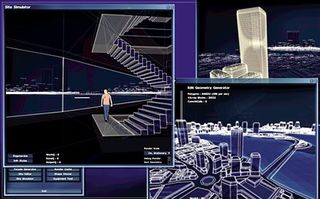First look at Subversion
Infiltration, acrobatics and conspiracy as Introversion return
It’s beautiful. We already know this. For over a year now, Introversion – independent developers and our favourite curry buddies – have teased us with a series of gorgeous development videos for their next game, Subversion. The videos show cities building themselves – lines of neon light that arrange themselves into urban sprawl, offices that assemble into neat little rows of flatpack prosperity. What we didn’t know is why. What is the game about? What’s it going to be like to play? What do you do?

Now, Introversion are ready to explain exactly what Subversion is, what kind of a game it will be and how they expect it to work. Put simply, explains Chris Delay, their lead designer, they’re making a game inspired by heist movies such as “Oceans 11, Sneakers, Entrapment, Hustle and Mission: Impossible.” He pauses. “The original TV series and first film. None of that John Woo shit.”
“It’s set in a modern high-tech environment,” he continues, “with you taking mission control over a team of skilled operatives in a hostile high security building. We want to create that feeling of a team of highly trained and skilled agents working silently somewhere deep in a secure building.” You play as the voice back at base, ordering your team where to go, what to hack, and how to get out alive. Think X-COM, or Commandos – but with more rapelling, more speaking into microphones in hushed tones and considerably fewer explosions.
Each of your operatives has his own abilities. Some are clever hackers, using electrical devices to disable cameras and collect data from secure equipment. Others are talented social engineers, distracting guards or receptionists. You could try precision explosives to blow down a door or ask your acrobat to shimmy up an elevator shaft. As Chris puts it, “In the best case scenarios your enemies will never know you were even there. When things go wrong, a well prepared escape plan and some well timed precision violence will get you out of a tight spot.”

For long-term Introversion followers, it feels like a return to the paranoia and tension of Uplink, their brilliant hacker simulation. In that, you took down companies from within their computers, getting in and out without leaving a trace. In Subversion, you do the same thing, but from within their offices. Introversion’s design for this game is interesting, not just because of the concepts they’re playing with. Their goal is to make something that’s far more systemic and open ended, as opposed to scripted puzzles with prescribed solutions.
For the first year of development, Chris spent his time working on generative systems, building algorithms and equations that would create line-art approximations of cities and the office blocks within. The city is meant to serve as the campaign map – the office blocks within are your ultimate target.
Improvising your way in is key. Chris describes the game as a complex system, and rather than building specific case scenarios for every object, they rely on software agents and modular AI to produce emergent effects. “Most games let you bypass a security system in one way only. We want to support many different ways to defeat any one system, depending on the kinds of agents you’re using and the kind of player you are. For example, we connect all the cameras on a floor to a camera control system in a secure room, and have that connected to security monitors, recording onto external tape devices. Each device is wired together, allowing you to attach bypassers, cut wires and so on.”
Sign up to the 12DOVE Newsletter
Weekly digests, tales from the communities you love, and more
Why go to this level of modelling? “The real benefits to this are a huge amount of richness to the way the world works, and hence a lot more ways you can break it to your advantage.” That level of detail requires clever new thinking about how AI responds to your actions. If Introversion can’t predict how you’ll break their game, they’ll have to rely on AI to do it for them.

“We’ve found that the key is to construct an AI system that doesn’t rely on specifics, but responds to generic events intelligently,” says Chris. “Pulling a gun will cause people to run away, not because you’re carrying a gun, but because you are emitting DANGER! AI events in all directions. In much the same way, if a room was on fire, it too would be emitting DANGER! events and characters would be running away from that, too."
But Subversion is still a work in progress: Introversion have a lot more to do before they’re ready to order their victory naan. We ask Chris how acrobatics will work in this blueprint world, where currently characters are just placeholder shapes. “Mark asked me the same question yesterday, and I don’t have a clear answer right now... the acrobats haven’t had much attention yet.”
Apr 9, 2010

















